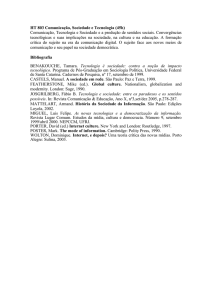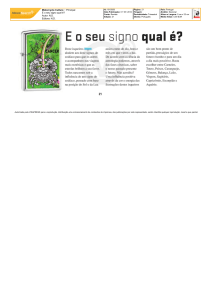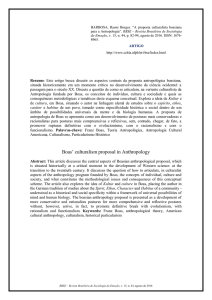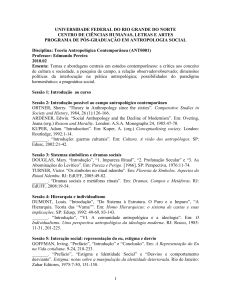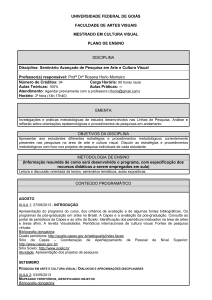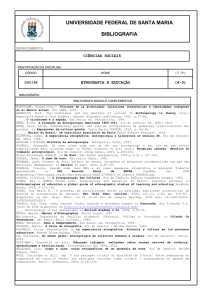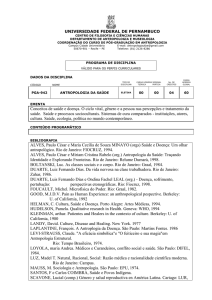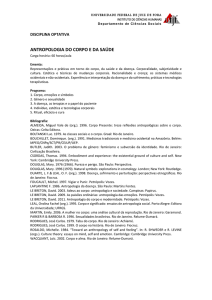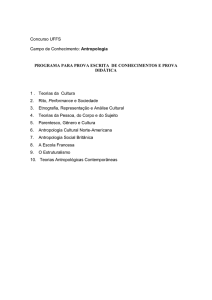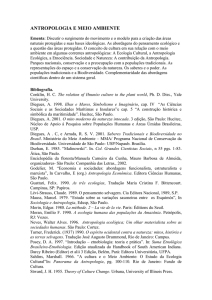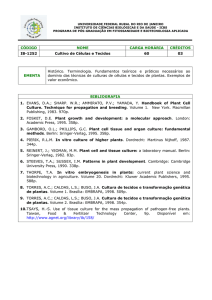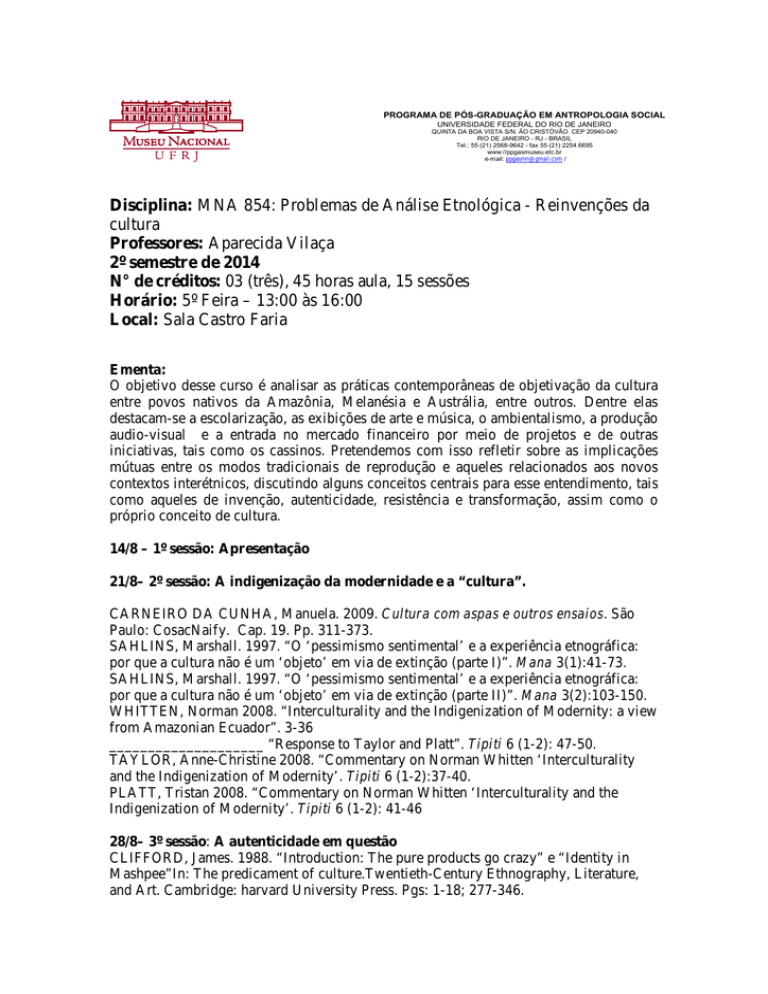
PROGRAMA DE PÓS-GRADUAÇÃO EM ANTROPOLOGIA SOCIAL
UNIVERSIDADE FEDERAL DO RIO DE JANEIRO
QUINTA DA BOA VISTA S/N. ÃO CRISTÓVÃO. CEP 20940-040
RIO DE JANEIRO - RJ - BRASIL
Tel.: 55 (21) 2568-9642 - fax 55 (21) 2254.6695
www://ppgasmuseu.etc.br
e-mail: [email protected] /
Disciplina: MNA 854: Problemas de Análise Etnológica - Reinvenções da
cultura
Professores: Aparecida Vilaça
2º semestre de 2014
N° de créditos: 03 (três), 45 horas aula, 15 sessões
Horário: 5º Feira – 13:00 às 16:00
Local: Sala Castro Faria
Ementa:
O objetivo desse curso é analisar as práticas contemporâneas de objetivação da cultura
entre povos nativos da Amazônia, Melanésia e Austrália, entre outros. Dentre elas
destacam-se a escolarização, as exibições de arte e música, o ambientalismo, a produção
audio-visual e a entrada no mercado financeiro por meio de projetos e de outras
iniciativas, tais como os cassinos. Pretendemos com isso refletir sobre as implicações
mútuas entre os modos tradicionais de reprodução e aqueles relacionados aos novos
contextos interétnicos, discutindo alguns conceitos centrais para esse entendimento, tais
como aqueles de invenção, autenticidade, resistência e transformação, assim como o
próprio conceito de cultura.
14/8 – 1º sessão: Apresentação
21/8– 2º sessão: A indigenização da modernidade e a “cultura”.
CARNEIRO DA CUNHA, Manuela. 2009. Cultura com aspas e outros ensaios. São
Paulo: CosacNaify. Cap. 19. Pp. 311-373.
SAHLINS, Marshall. 1997. “O ‘pessimismo sentimental’ e a experiência etnográfica:
por que a cultura não é um ‘objeto’ em via de extinção (parte I)”. Mana 3(1):41-73.
SAHLINS, Marshall. 1997. “O ‘pessimismo sentimental’ e a experiência etnográfica:
por que a cultura não é um ‘objeto’ em via de extinção (parte II)”. Mana 3(2):103-150.
WHITTEN, Norman 2008. “Interculturality and the Indigenization of Modernity: a view
from Amazonian Ecuador”. 3-36
____________________ “Response to Taylor and Platt”. Tipiti 6 (1-2): 47-50.
TAYLOR, Anne-Christine 2008. “Commentary on Norman Whitten ‘Interculturality
and the Indigenization of Modernity’. Tipiti 6 (1-2):37-40.
PLATT, Tristan 2008. “Commentary on Norman Whitten ‘Interculturality and the
Indigenization of Modernity’. Tipiti 6 (1-2): 41-46
28/8– 3º sessão: A autenticidade em questão
CLIFFORD, James. 1988. “Introduction: The pure products go crazy” e “Identity in
Mashpee”In: The predicament of culture.Twentieth-Century Ethnography, Literature,
and Art. Cambridge: harvard University Press. Pgs: 1-18; 277-346.
2
HANSON, Allan. 1989. "The Making of the Maori: Culture Invention and Its Logic",
American Anthropologist 91(4): 890-902.
LEVINE, H. B. 1991. “Comment on Hanson's ‘The Making of the Maori’”. American
Anthropologist 93(2): 444-446.
LINNEKIN, Jocelyn. 1991. "Cultural Invention and the Dilemma of Authenticity",
American Anthropologist 93(2): 446-449.
BERSON, Josh. 2014. The Dialectal Tribe and the Doctrine of Continuity. Comparative
Studies in Society and History 56(2): 381-418
GORDILLO, Gastón. 2011. Longing for Elsewhere: Guaraní Reterritorializations.
Comparative Studies in Society and History 53(4): 855-881
STASCH, Rupert. 2011 “The Camera and the House: The Semiotics of New Guinea
Treehouses” in Global Visual Culture”. Comparative Studies in Society and History
53(1): 75-112
4/9– 4º sessão: A invenção da cultura
WAGNER, Roy. 1975. The invention of culture. New Jersey: Prentice-Hall. Caps 1 a 4.
[ A invenção da cultura. Cosacnaify, 2010]
VIVEIROS DE CASTRO, Eduardo 2004. “Perspectival Anthropology and the Method
of Controlled Equivocation” Tipití 2(1): 3-22.
KELLY, J. A 2005. “Notas para uma teoria do ‘virar branco’. Mana. Estudos de
Antropologia Social 11(1): 201-234.
11/9– 5º sessão: Kastom na Melanésia
BABADZAN, Alain 2004. “Commentary: Kastom as Culture?”. Anthropological
Theory, 4(3): 325-8.
AKIN, David 2005. “Kastom as hegemony? A response to Babadzan”. Anthropological
Theory, 5(1): 75-83.
AKIN, David. 2004. “Ancestral Vigilance and the Corrective Conscience: Kastom as
Culture in a Melanesian society”. Anthropological Theory, 4(3): 299-324.
KEESING, Roger. 1982. “Kastom in Melanesia: An Overview”. In: Roger Keesing and
Robert Tonkinson (eds.) Reinventing Traditional Culture: The Politics of Kastom in
Island Melanesia. Mankind special issue 13(4): 297–301.
SCHWARTZ, T. 1993. “Kastom, ‘custom’ and culture: Conspicuous culture and
culture-constructs.” Anthropological Forum 6(4): 515–540.
18/9– 6º sessão: O efeito da cultura entre os aborígenes
GERSHON, Ilana. 2008. “Being Explicit about Culture: M•ori, Neoliberalism, and the
New Zealand Parliament”. American Anthropologist, v. 110, n. 4: 422-31.
COWLISHAW, Gillian 2011. “Mythologizing culture 2: disturbing aboriginality in the
suburbs”. The Australian Journal of Anthropology 21: 208-227.
__________________2012. “Culture and the absurd: the means and meaning of
Aboriginal identity in the time of cultural revivalism”. JRAI (N.S.) 18 (2): 397-417
BATTY, P. 2007. “White redemption rituals: reflections on the repatriation of
Aboriginal secret-sacred objetcs”. In: T. Lea, E. Kowal & G. Cowlishaw (eds), Moving
Anthropology: critical Indigenous studies. Darwin: Charles Darwin University Press.
3
LAMBERT-PENNINGTON, K. 2007. “What remains? Reconciling repatriation,
Aboriginal culture, representation and the past”. Oceania 77: 313-336.
MEYERS, F. 1994. “Culture-making: performing Aboriginality in the Asia Society
Gallery”. American Ethnologist 21: 679-699.
SULLIVAN, P. 2006. “Introduction: culture without cultures – the culture effect”. The
Australian Journal of Anthropology 17: 253-264.
25/9– 7º sessão: A atividade missionária e a objetivação da cultura na América
Latina
ORTA, Andrew. 2004. Catechizing culture. Missionaries, Aymara, and the “New
Evangelization”. New York: Columbia University Press. Capítulos a escolher.
RUFINO, Marcos. 2006. “O código da cultura: o CIMI no debate da inculturação”in
Montero, Paula (org), Deus na aldeia: missionários, índios e mediação cultural. São
Paulo: Globo. [
NOVAES, Sylvia1999. “A épica salvacionista e as artimanhas da resistência - as
missões salesianas e os Bororo de Mato Grosso”. In: Wright, Robin (ed.),
Transformando os deuses. Os múltiplos sentidos da conversão entre os povos indígenas
do Brasil. São Paulo: Editora Unicamp Pps: 343-362.
Bibliografia complementar
RUFINO, Marcos. 2002. “Ide, portanto, mas em silêncio”. Faces de um indigenismo
católico heterodoxo. Tese de doutorado. Departamento de Antropologia, Universidade
de São Paulo.
2/10– 8º sessão: Imagens amazônicas 1
TURNER, Terence. 1994. "Imagens desafiantes: a apropriação kayapó do vídeo".
Revista de Antropologia, 36:81-122.
TURNER, Terence. 1991. "Representing, resisting, rethinking. Historical
transformations of Kayapo culture and anthropological counsciousness", in G. W.
Stocking (ed.), Colonial Situations: Essays on the Contextualization of Ethnographic
Knowledge. Madison: University of Wisconsin Press. pp. 285-313.
JACKSON, Jean E. 1995. "Culture, genuine and spurious: the politics of indianness in
the Vaupés, Colombia", American Ethnologist, 22(1): 3-27.
ANDRELLO, Geraldo. 2012. Histórias tariano e tukano: política e ritual no rio Uaupés.
Revista de Antropologia, 55(1). Disponível em:
<http://www.revistas.usp.br/ra/article/view/46967>.
ALBERT, Bruce 1997 ‘Ethnographic Situation’ and Ethnic Movements. Notes on postMalinowskian fieldwork. Critique of Anthropology vol.17 n.1: 53-65.
9/10– 9º sessão: Imagens amazônicas 2
CONKLIN, Beth A. 1997. “Body Paint, Feathers and VCRs: Aesthetics and
Authenticity in Amazonian Activism”, American Ethnologist, Volume(4): 711-37.
CONKLIN, Beth. 2002. “Shamans versus Pirates in the Amazonian Treasure Chest”.
America Anthropologist. 104(4): 1050-1061.
GRAHAM, Laura R. 2005. “Image and Instrumentality in a Xavante Politics of
Existential Recognition: The Public Outreach Work of Eténhiritipa Pimentel Barbosa.”
American Ethnologist 32(4): 622–641.
4
MARTINI, André. 2012 O retorno dos mortos: apontamentos sobre a repatriação de
ornamentos de dança (basá busá) do Museu do Índio, em Manaus, para o rio Negro.
Revista de Antropologia, 55(1). Disponível em:
<http://www.revistas.usp.br/ra/article/view/46968>.
MACEDO, Valéria. 2012 Dos cantos para o mundo. Invisibilidade, figurações da
“cultura” e o se fazer ouvir nos corais guarani. Revista de Antropologia, 55(1).
Disponível em: <http://www.revistas.usp.br/ra/article/view/46969>.
16/10– 10º sessão: O comércio da cultura
CATTELINO, Jessica. 2011. “One Hamburger at a Time: revisiting State-Society
divide with the Seminole Tribe and Hard Rock International”. Current Anthropology,
52 (3): S137-S149.
DOBROWISKI, K. 2001. Against culture: development, politics and religion in Indian
Alaska. Lincoln: University of Nebraska Press. [Partes a escolher].
GORDON, Cesar. 2010. “L’inflation à la mode Kayapó : Rituel, marchandise et
monnaie chez les Xikrin (Kayapó) de l Amazonie brésilienne”. Journal de la Société
des Américaniste. 96: 205-228.
FIORINI, Marcelo et BALL, Christopher, 2006. “Le commerce de la culture, la
médecine rituelle et le Coca-Cola.” Gradhiva 4:97-113.
VELDEN, Felipe Ferreira Vander. 2012. As flechas perigosas: notas sobre uma
perspectiva indígena da circulação mercantil de artefatos. Revista de Antropologia,
54(1). Disponível em: <http://www.revistas.usp.br/ra/article/view/38593/41446>.
SANTINI, Sylvano. 2009. “D’un point de vue Inuit: les films des productions Igloolik
Isuma”. Spirale: arts, lettre, sciences humaines, n. 225: 19-22.
BUNTEN, Alexis Celeste. 2008. “Sharing culture or selling out? Developing the
commodified persona in the heritage industry”. American Ethnologist, v. 35, n. 3: 38095
SYLVAIN, Renée . 2005. "Disorderly development: Globalization and the idea of
“culture” in the Kalahari". American Ethnologist, v. 32, n. 3: 354-70
EGGEN, Oyvind. 2012.Performing Good Governance: The Aesthetics of Bureaucratic
Practice in Malawi. Ethnos, 77 (1): 1–23
23/10– 11º sessão : Ensinando a cultura
DAVELUY, Michele. 2009. “Inuit education in Alberta and Nunavik (Canada)”. Études
Inuit, vol. 33: 173-190.
SALADIN D’ANGLURE, Bernard. 1988. “Les Inuit à l’école de Rabelais, de
Descartes ou de Lévi-Strauss ? Regard anthropologique sur l’éducation
interculturelle.” F. Ouellet (org.), Pluralisme et école. Québec: Institut québécois de
recherche sur la culture, pp. 437-464.
CESARINO, Pedro de Neimeyer. 2012. A escrita e os corpos desenhados:
transformações do conhecimento xamanístico entre os Marubo. Revista de
Antropologia, 55(1). Disponível em:
<http://www.revistas.usp.br/ra/article/view/47583>.
JACKSON, Jean E. 1995. “Preserving Indian Culture: Shaman Schools and EthnoEducation in the Vaupés, Colombia”. Cultural Anthropology 10:302-329.
5
LOPES DA SILVA, Aracy. 2002. “Pequenos 'xamãs': crianças indígenas, corporalidade
e escolarização”. In: Aracy Lopes da Silva; Angela Nunes; Ana Vera Lopes da Silva
Macedo (Orgs). Crianças Indígenas: ensaios antropológicos. São Paulo: Global, pp.
37-63.
HUGH-JONES, Stephen. 1997. “ Education et culture: réflexions sur certains
développements dans la région colombienne du Pira-Paraná”. Cahier des Amériques
Latines, 23: 95-121.
BALLANTYNE, Tony. 2011. Paper, Pen, and Print: The Transformation of the Kai
Tahu Knowledge Order. Comparative Studies in Society and History 53(2): 232-260.
30/10– 12º sessão : A escola indígena na Amazônia
WEBER, Ingrid. 2006. Um copo de cultura. Os Huni Kui (Kaxinawá) do Rio Humaitá
e a escola. Rio Branco, EDUFAC, Rio de Janeiro, Nuti. Parte II. Pg 126-225.
COHN, Clarisse. 2004. “Os processos próprios de ensino e aprendizagem e a escola
indígena”. Cadernos de Educação Escolar Indígena – 3o grau indígena. Barra do
Bugres: UNEMAT, v. 3, n. 1: 94-111.
LASMAR, Cristiane. 2009. “Conhecer para transformar: os índios do rio Uaupés (Alto
Rio Negro) e a educação escolar” Tellus, ano 9, n. 16, p. 11-33.
PALADINO, Mariana. 2010. “Experimentando a diferença - Trajetórias de jovens
indígenas Tikuna em escolas de Ensino Médio das cidades da região do Alto Solimões,
Amazonas”. Currículo sem Fronteiras, v.10, n.1, pp.160-181.
TASSINARI, Antonella Maria Imperatriz. (2001). “Escola Indígena: novos horizontes
teóricos, novas fronteiras da educação”. In: Aracy Lopes da Silva; Mariana Kawall Leal
Ferreira (orgs). Antropologia, História e Educação: a questão indígena e a escola. São
Paulo: Global. pp. 44-70.
6/11– 13º sessão: : Ambientalismo
ALBERT, Bruce 2002. “O ouro canibal e a queda do céu: uma crítica xamânica da
economia política da natureza (Yanomami)”. In: ALBERT, B. & RAMOS, A. (eds.)
Pacificando o branco. Cosmologias do contato no Norte-Amazônico. São Paulo:
Unesp/Imprensa Oficial do Estado; Paris: IRD. pp. 239-274.
WEST, Paige. 2005. "Translation, Value, and Space: Theorizing an Ethnographic and
Engaged Environmental Anthropology". American Anthropologist, v. 107, n. 4.: 63642.
CEPEK, Michael. 2011. "Foucault in the forest: Questioning Environmentality in
Amazonia". American Ethnologist, v. 38, n. 3: 501-515.
KIRSCH, Stuart. 2008. "Social Relations and the Green Critique of Capitalism in
Melanesia". American Anthropologist, v. 110, n. 3: 288-98.
RUFINO, Marcos Pereira. 2013. Águas da discórdia: a transposição das águas do Rio
São Francisco e as mudanças de curso da missão indigenista católica. Revista de
Antropologia, 56(1). Disponível em:
<http://www.revistas.usp.br/ra/article/view/64459>.
6
13/11– 14º sessão: Patrimônio, propriedade
STRATHERN, Marilyn 1996 “Potential Property. Intellectual rights and property in
persons” Social Anthropology 4(1): 17-32.
HARRISON, Simon. 1999. "Identity as a scarce resource". Social Anthropology,
7(3):239-251.
MOUTU, Andrew. 2009. “The Dialectic of Creativity and Ownership in Intellectual
Property Discourse”. International Journal of Cultural Property 16:309–324.
BROWN, Michael. 1998. "Can culture be copyrighted?". Current Anthropology,
39(2):193-222.
ARAGON, Lorraine & LEACH, James. 2008. “Arts and owners: Intellectual property
law and the politics of scale in Indonesian arts”. American Ethnologist, 35(4): 607-31.
GEISMAR, Haidy. 2005. "Copyright in context: Carvings, carvers, and commodities in
Vanuatu". American Ethnologist, 32(3): 437-59.
27/11– 15º sessão: Discussões amazônicas sobre propriedade e patrimônio.
COELHO DE SOUZA, Marcela. 2005. “A propriedade da cultura no Brasil central
indígena”. Revista do Patrimônio Histórico e Nacional, 32:316-335.
SOUZA, Marcela Stockler Coelho de. 2012. A pintura esquecida e o desenho roubado:
contrato, troca e criatividade entre os K«sêdjê. Revista de Antropologia, 55(1).
Disponível em: <http://www.revistas.usp.br/ra/article/view/46965>.
CUNHA, Manuela Carneiro da. 2012. Questões suscitadas pelo conhecimento
tradicional. Revista de Antropologia, 55(1). Disponível em:
<http://www.revistas.usp.br/ra/article/view/46971>.
VIENNE, Emmanuel de et ALLARD, Olivier. 2005. “Pour une poignée de dollars?
Transmission et patrimonialisation de la culture chez les Trumai du Brésil central”.
Cahiers d’Études en Amérique Latine. 126-145.
BARCELOS NETO, Aristóteles. 2006. “Des villages indigènes aux musées
d’anthropologie.” Gradhiva 4:87-95.
GALLOIS, Dominique. 2007. “Materializando saberes imateriais: experiências
indígenas na Amazônia brasileira”. Revista de Estudos e Pesquisas, FUNAI: 95-116
GALLOIS, Dominique Tilkin. 2012. Donos, detentores e usuários da arte gráfica
kusiwa. Revista de Antropologia, 55(1). Disponível em:
<http://www.revistas.usp.br/ra/article/view/46956>.
GALLOIS, Dominique Tilkin . Os Wajãpi em frente da sua cultura. Revista do
Patrimônio Histórico e Artístico Nacional, v. 32, p. 110-129, 2005.
LIMA, Edilene Coffaci de. 2012. “A gente é que sabe” ou sobre as coisas katukina
(pano). Revista de Antropologia, 55(1). Disponível em:
<http://www.revistas.usp.br/ra/article/view/46962>.
CESARINO, Pedro de Niemeyer. 2010. Donos e Duplos: relações de conhecimento,
propriedade e autoria entre Marubo . Revista de Antropologia, 53(1).Disponível em:
<http://www.revistas.usp.br/ra/article/view/27348>.

